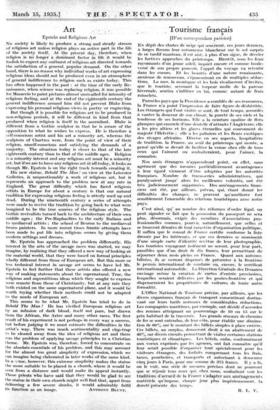Art
Epstein and Religious Art
No society is likely to produce a strong and steady stream of religious art unless religion plays_ an active part in the life of the society itself., At the present dak, therefore, when religion is no longer a .dominant factor in life it would he foolish to expect any 'outburst of religious at directed towards the satisfaction of a general, popular demand. On the other hand, there is no reason why, individual works of art expressing religious 'ideas should not be produced even in an atmosphere of general indifference to religion such as exists today. This has often happened in the past : at the time of the early Re- naissance, when science was replacing religion, it ,was possible for Masaccio to paint pictures almost unrivalled for intensity of religious feeling, and at the end of the eighteenth century the general indifference around him did not prevent Blake from expressing his personal religious .views in poetry or engraving.
But though it is possible for religious art to be produced in non-religious periods, it will be ,different in kind from that produced when religion is itself in the ascendant. Blake is different from a Gothic sculptor in that he is aware of the opposition to what he wishes to express. He is therefore a self-conscious artist and his art a minority art, whereas the sculptors of Chartres were, from the point of view of their religion, unself-conscious and satisfying the demands of a majority. The situation today is closer to that of the late eighteenth century than to that of the middle ages. Religion is a minority interest and any religious art must be a minority art, but if we are to have any religious art tall today, it looks as though Mr. Epstein is on the right track towards creating it.
His new statue, Behold The Man? on view at the Leicester Galleries, is unquestionably a work of religious 'art, but it represents an approach to the problem new at any rate in England.' The great 'difficulty which has &tied religions artists in Europe for about a century is that our natural tradition for expressing religious feeling is utterly used up and dead. During the nineteenth century a series of attempts were made to revive the tradition by going back to what were imagined to be the true sources of the religious style. The Gothic revivalists turned back to the architecture of their own middle ages ; the Pre-Raphaelites to the early Italians and to mediaeval artists ; the school of Beuron to the mediaeval fresco painters. In more recent times frantic 'fitterimts have been made to put life into religious scenes by giving them modern settings and dresses.
Mr. :Epstein has approached the problem differently. His interest.in the arts of the Savage races was started, we may imagine, by realizing that they offered a new way of looking at the material world, that they were based on formal principles wholly different from those of European art. But this more or less technical interest in savage art seems to have led Mr. Epstein to feel further that these artists also offered a new way of making statements about the supernatural. True, the religious and superstitious ideas which they sought to express were remote from those of Christianity, but at any rate they both existed on the same supernatural plane, and it would be worth trying whether their methods &mid not be adapted to the needs of European art.
This seems to be what Mr. Epstein has tried to do in Behold The Man ! He has vivified European religious art by an infusion of dark blood, itself not pure, but drawn from the African, the Aztec and many other races. The first result of his experiment is not perhaps in every way a success, but before judging it we must estimate the difficulties in the artist's way. There was much sentimentality and clap-trap to be cleared away from the idea of religions art and there was the problem of applying savage principles to a Christian theme. Mr. Epstein was, therefore, forced to concentrate on the absolute essentials of his problem, and this may account for the almost too great simplicity of expression, which we can imagine being elaborated in later works of the same kind. In a -.-sase, however, this extreme simplicity makes the statue the more suitable to be placed in a Church, where it would be seen from a distance and would make its appeal instantly. Those priests who have said that they would be glad to see the statue in their own church might well find that, apart from delivering a few severe shocks, it 'would admirably fulfil










































 Previous page
Previous page